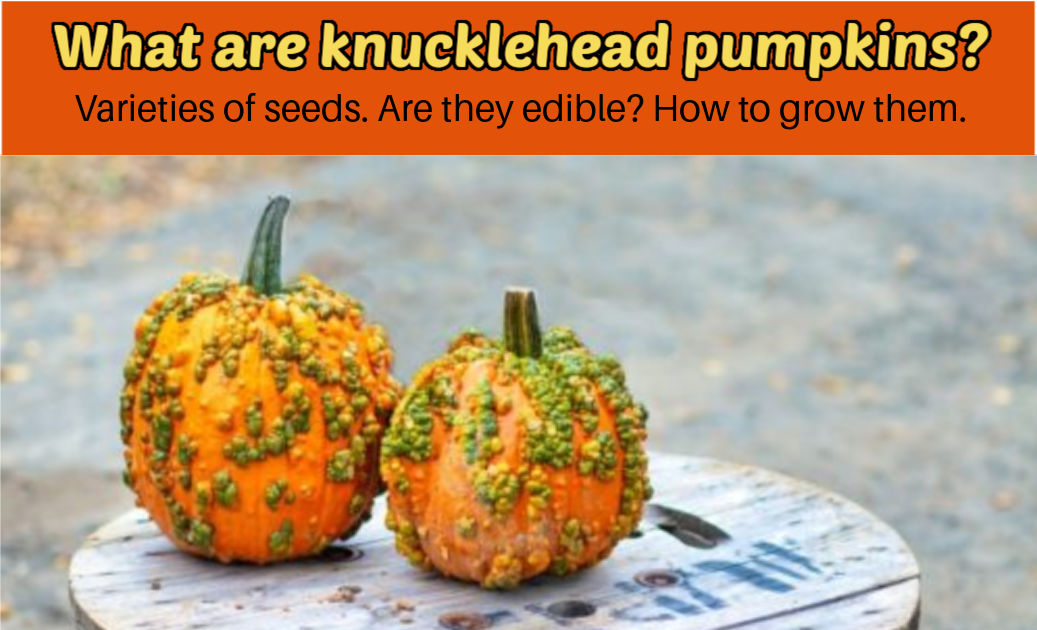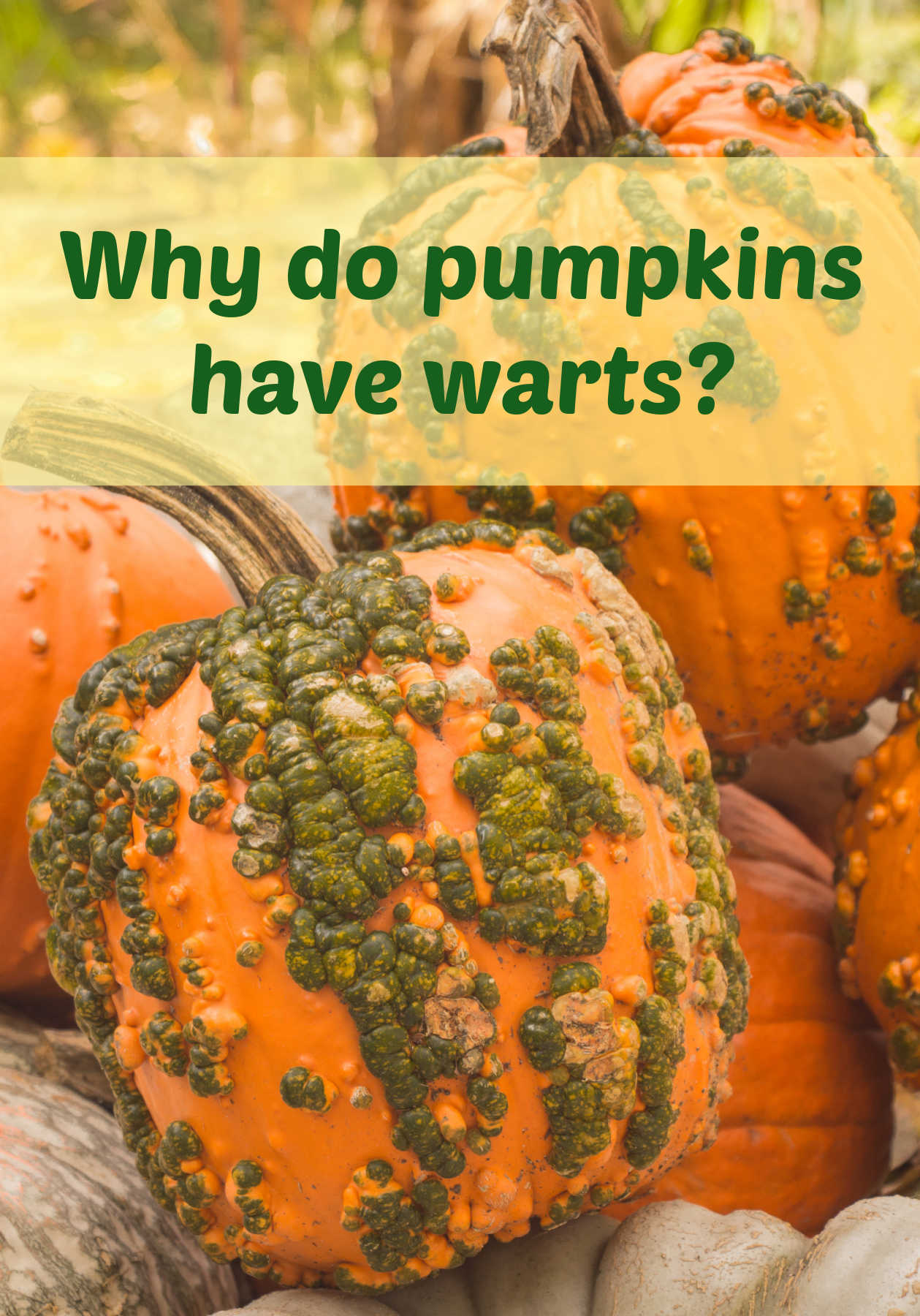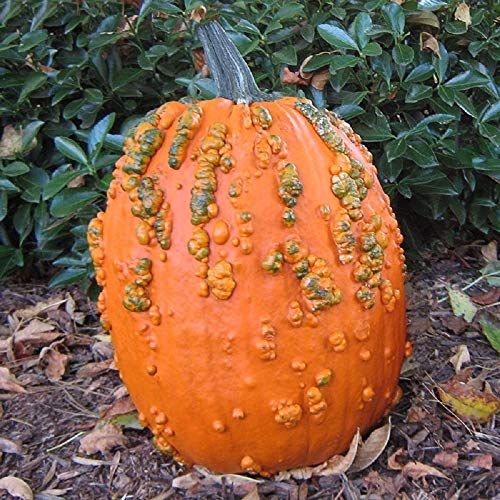Knucklehead pumpkins stand out because of their unusual, bumpy skin. This makes them a favorite for fall displays and Halloween decorating.
Many people wonder why some pumpkins grow with warts while others stay smooth. The answer depends on both genetics and growing conditions.
Some pumpkins, like the knucklehead variety, are bred to develop those wart-like bumps as a natural part of their appearance. In other cases, the bumps may show up because of plant stress or certain diseases.
Knowing the difference helps you decide whether a pumpkin is simply decorative or showing signs of a problem.
In this guide, we’ll explain what knucklehead pumpkins are, why pumpkins develop warts, and how to tell if your crop is healthy. You’ll also learn whether warty pumpkins are safe to eat and get tips for growing and displaying them.

As an Amazon Associate, I earn from qualifying purchases. Some of the links below are affiliate links. I earn a small commission, at no extra cost to you, if you purchase through one of those links.
What are knucklehead pumpkins?
Have you ever headed to the pumpkin patch to get your pumpkin to carve, only to discover lots of pumpkins with warts on them? This begs the question: “Why do pumpkins have warts?”
You may wonder whether this condition means that you have harvested too late, and your pumpkin will rot more quickly?
In many cases, knucklehead pumpkins have been genetically engineered to look this way!
It can take at least 10 generations of cross-breeding to produce a knucklehead pumpkin that is sufficiently covered in warts to attract those who love this look.
Knucklehead pumpkins were first created and patented in 2008 in Holland, Michigan, by the Siegers Seed Company, which has since been acquired by Stokes Seeds.
This type of pumpkin has a rind that has vertical ridging and can vary in color from dark green to bright orange. It is covered in warts or bumps when the pumpkin matures.
Saved seeds from warty pumpkins do not breed true to the parent, unfortunately. To get this look, you will need to buy seeds that have been produced especially to grow a pumpkin with warts.

Environmental causes and diseases that create warts on pumpkins
Not all bumpy pumpkins are specially bred knucklehead varieties. Sometimes, warts appear because of stress or disease during the growing season.
Some common environmental causes of pumpkins with warts:
Mosaic Virus
- This is one of the most common pumpkin diseases that leads to wart-like bumps.
- In this case, the bumps will look as though they formed under the skin, instead of on top of it.
- It spreads through insects such as aphids.
- In addition to bumpy skin, infected plants may show mottled or distorted leaves and stunted growth.
- Fruit from virus-infected plants is usually safe to eat, but it may not store as well.
Edema (Water stress)
- Edema happens when pumpkin plants absorb more water than they can release.
- The excess water causes cells on the fruit surface to rupture, leaving scars and blister-like bumps.
- It’s more common in wet conditions or poorly drained soil.
- Edema doesn’t affect edibility, but it can make pumpkins less attractive for display.
Other Environmental Factors
- Extreme temperature swings and inconsistent watering can add stress that sometimes results in surface blemishes.
- These bumps are harmless but can make the fruit look unusual compared to smooth-skinned pumpkins.
 How to Tell the Difference
How to Tell the Difference
If your pumpkins have warts, these quick signs will help you tell whether they’re knucklehead pumpkins or the result of stress or disease:
- Knucklehead pumpkins – The warts are uniform, appear early, and cover the pumpkin consistently. The plant stays healthy and has normal leaves and growth.
- Mosaic virus – Warts are irregular and often paired with mottled or distorted leaves. Pumpkins may look misshapen.
- Edema (water stress) – Bumps appear after excess rain or watering. They look more like scabs or blisters and usually don’t affect the whole fruit.

Can you eat warty pumpkins?
The flesh of knucklehead pumpkins is yellow-orange and dense with cream-colored seeds.
Knucklehead pumpkins are most often used as decorative pumpkins, but can also be used cooked. When you cook bumpy pumpkins, you will get a very sweet and mild flavor.
These warty pumpkins are ideally suited to roasting, baking, and boiling for your recipes. Use them as side dishes for Thanksgiving, or roast and use the flesh in salads and soups.
You can also use knucklehead pumpkins in sweet recipes such as pumpkin chili, pumpkin cookies, pumpkin muffins, puddings, and pumpkin cakes.
The seeds can be roasted and salted for a healthy snack.
Basically, once you get past the idea of dealing with the warts, you can use them in cooking the same as you would a normal pumpkin.

Growing knucklehead pumpkins
Knucklehead pumpkins grow best in full sun with well-draining, fertile soil. Space plants about 3–5 feet apart to allow room for vines to spread.
Keep the soil consistently moist but not waterlogged to prevent edema. Regular feeding with a balanced fertilizer supports healthy growth and encourages the characteristic warts.
For best results, start seeds indoors 2–4 weeks before the last frost, or plant directly outdoors once the soil has warmed.
With proper care, your pumpkins will develop the unique bumpy skin that makes knucklehead varieties so distinctive.

Varieties of knucklehead pumpkin seeds
Since knucklehead pumpkins are now a popular commodity, growers keep coming up with new bumpy pumpkin varieties. If you would like to try your hand at growing them, some popular seeds are:
- Frankenstein scarface – Bright orange with an oval shape
- Warty Goblin – Hard orange shell with green bumps
- Marina di Chioggia – Warty blue squash
- Galeux Eysines – Blistered skin resembling peanut shells
With the right seeds in hand, you can have a whole garden full of knucklehead pumpkins in the fall. You can print out the growing tips in the card at the bottom of the post to grow your own warty pumpkins.
Using knucklehead pumpkins for decorating
For many years, the average pumpkin lover searched for the smoothest pumpkins they could find. The reason is that carving pumpkins is thought to be easier with this type of pumpkin.
Now, though, knucklehead pumpkins, along with heirloom pumpkins of various colors and shapes, are all the trend for decorating.
Bumps, warts, lumps, and pronounced ridges all lend character to a pumpkin. Warts are now considered in, and the more the better!
These pumpkins add to the ghoulish appearance of a carved pumpkin, and knucklehead pumpkins have become all the rage.
Using pumpkins with warts in your pumpkin decor projects gives a new and interesting look to your fall decorating. Try some of these ideas:
- Arrange warty pumpkins on bales of hay for a rustic look.
- Add them to fall front porch decor.
- Paint faces on them for a ghoulish no-carve pumpkin look.
- Paint warty pumpkins white for a real show-stopper!

Share this post about knucklehead pumpkins on X
If you enjoyed learning why pumpkins have warts, be sure to share this article with a friend. Here is a post to get you started:
🤔🌱Why do some pumpkins have warts? The answer may surprise you. Head to The Gardening Cook for the scoop on those bumpy skins! 🍂🧑🌾🎃🎃 #Pumpkins #FallDecor #GardeningTips #Halloween Share on X
Pin this post about knucklehead pumpkins for later.
Would you like a reminder of these warty pumpkin facts? Just pin this image to one of your vegetable gardening boards on Pinterest so that you can easily find it later.
Warty pumpkins are odd and unique, but then again, everything about Halloween is odd and unique. So they fit right in!
Knucklehead pumpkins are large and ghoulish-looking. Their warty orange skin gives off a spooky appearance that is perfect for Halloween. Why not try one this year?
Admin note: This article about warty pumpkins first appeared on the blog in September 2020. This post has been updated with new photos, a printable growing card, and a slideshow video about decorating for fall with natural elements.
Growing Knucklehead Pumpkins

Smooth pumpkins used to be all the rage, but lately, pumpkins covered in warts, known as knucklehead pumpkins, seem to be the trend now.
They grow from special seeds. Read on to find out how to grow knucklehead pumpkins.
Materials
- Knucklehead pumpkin seeds
- Compost or other organic matter
Tools
- Hose or watering can
Instructions
- For best results, start seeds indoors 2–4 weeks before the last frost, or plant directly outdoors once the soil has warmed.
- Choose an area that gets full sunlight.
- Add organic matter or compost to the soil and till it under.
- Plant outdoors after all danger of frost has passed. Knucklehead pumpkin plants thrive in warm soil.
- Plant the seeds 1/2 - 1 inch deep. Space the seeds 3-5 feet apart.
- Space the seeds well. Knucklehead pumpkins can grow up to 12 inches in size, and the vines need room to spread out.
- Plant in 12-18 inch mounds to encourage warmth.
- Water well and allow to drain. Soil should be damp, not saturated, to prevent edema.
- Fertilize with a balanced fertilizer monthly during the growing season to encourage the warts to grow.
- Harvest in 100 - 110 days, depending on your variety.
- Harvest when the pumpkins look no longer naturally damp and the skin is stiff. Leave a stem when harvesting.
- Store in a dry location between 55 and 70 degrees F with normal humidity.
Recommended Products
As an Amazon Associate and member of other affiliate programs, I earn from qualifying purchases.



Cassie
Tuesday 30th of May 2023
I wanted to add that we didn't plant them. They are just growing where they landed.
Cassie
Tuesday 30th of May 2023
I had one that dried out over the winter and spring. My kid broke it open several weeks ago and now we have tiny pumpkin starts in front of our planter bed. I wonder what they will look like since they won't have warts.
Carol Speake
Wednesday 31st of May 2023
What a fun discovery. Hitchhiker plants (also called volunteer plants) are interesting to watch to see how they form.
Rachel
Tuesday 2nd of August 2022
Hello! I love your information on the knucklehead pumpkins, though have something to add on the seeds not sowing true. See, I have grown these for the past three years. But I haven't done so intentionally. I have never purchased these seeds, ever. But I do collect donated pumpkins in the fall once folks are done using them for decor and I feed them to my pigs. I get volunteers in both my pastures and in my garden because I add manure to my compost. One year I got loads of ghost pumpkins, the small round white ones, as well as these warts looking ones. I wish I could add pictures because I've got several growing in my asparagus bed right now, LOL! So, I don't think it would be a total waste of time for folks to try and grow these themselves from seed saving. They start out smooth and green with stripes, almost like a watermelon. Then they get knotty bumps all over them. Later, the skin turns orange, but the bumps remain green. It's really cool to witness the progression. I've got still other volunteers I'm trying to figure out - maybe acorn squash! It's a fun game every year.
Chris
Saturday 6th of August 2022
@Rachel, Lol same thing here. I started with porch decorations. I also live on a farm and have a manure pile. We tossed the decorations on the compost after fall decorations were done for. I have a large pumpkin patch of warty pumpkins at the moment. Exactly one pumpkin has a smooth skin on it. 99% are bumpy.